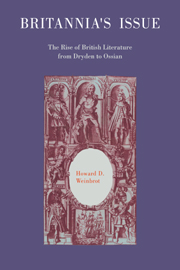Book contents
- Frontmatter
- Contents
- Acknowledgments and editorial notes
- INTRODUCTION: An overview of scope and method
- PART I CONTEXTS: INTELLECTUAL, PSYCHOLOGICAL, AND NATIONAL
- PART II TEXTS WITHIN CONTEXTS. ESSAYING ENGLAND: OUR GENIUS, OUR CLIME
- PART III GROWING ONE'S OWN. THE BRITISH ODE FROM COWLEY TO GRAY
- PART IV EXPANDING THE BORDERS. JEWS AND JESUS: THIS ISRAEL, THIS ENGLAND
- PART V CELTS, GERMANS, AND SCOTS: TOWARDS A UNITED KINGDOM
- APPENDIX: The text of Handel's “Israel in Egypt”
- Index
INTRODUCTION: An overview of scope and method
Published online by Cambridge University Press: 15 December 2009
- Frontmatter
- Contents
- Acknowledgments and editorial notes
- INTRODUCTION: An overview of scope and method
- PART I CONTEXTS: INTELLECTUAL, PSYCHOLOGICAL, AND NATIONAL
- PART II TEXTS WITHIN CONTEXTS. ESSAYING ENGLAND: OUR GENIUS, OUR CLIME
- PART III GROWING ONE'S OWN. THE BRITISH ODE FROM COWLEY TO GRAY
- PART IV EXPANDING THE BORDERS. JEWS AND JESUS: THIS ISRAEL, THIS ENGLAND
- PART V CELTS, GERMANS, AND SCOTS: TOWARDS A UNITED KINGDOM
- APPENDIX: The text of Handel's “Israel in Egypt”
- Index
Summary
How does a great nation determine its identities? In Britain's case, slowly and by accident more than by design; by processes that encourage both change and stability, both reluctant reaching out to alien strains and insistence on apparently native power and virtues. The new blend is an often discordant concordia discors that can stimulate literary greatness. Such, I shall argue, is one among many approximate shapes of historical, intellectual, and literary events from the mid-1660s to the mid-1760s in Britain. The native view of Anglo-Saxon heritage polished by expanding Rome is modified to include Scottish Celtic and Hebrew Jewish cultures; each enriches while threatening both the nation and these important minorities; and each supports the ongoing reconsideration of southern classical achievement as the dominant guide for a northern modern island.
In 1746 serious Englishmen writing in serious journals for serious readers called for “the total extirpation” of the Scottish people. In 1757 William Pitt invites the most dangerous of those people to fight for not against Great Britain. Two regiments of once rebellious Highlanders serve brilliantly in the Seven Years' War – that is, with terrible casualties in generally successful battles. In 1753 the bill for naturalization of Jews born in Britain is withdrawn upon irrational cries that omnipresent Jews would abolish the eating of pork and force the circumcision of innocent British men, boys, and horses. In 1817 Isaac D'Israeli (b. 1766) resigns from his Sephardic synagogue and baptizes his thirteen-year-old son Benjamin in the Church of England. Benjamin becomes Prime Minister in 1867 and the first Earl of Beaconsfield in 1876.
- Type
- Chapter
- Information
- Britannia's IssueThe Rise of British Literature from Dryden to Ossian, pp. 1 - 16Publisher: Cambridge University PressPrint publication year: 1993



